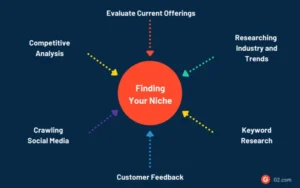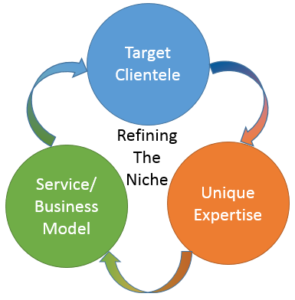Finding your niche is the cornerstone of building a fulfilling and a successful life. Whether you’re at a crossroads in your career, contemplating a bold new venture, or simply yearning for a more fulfilling life, finding your niche is essential for growth. It’s about identifying a specific market segment where you can excel and stand out from the competition. While it might seem daunting, with the right approach, you can discover your ideal niche and position yourself for success. In this post, we will go through six actionable steps designed to help you delve deep into your interests, strengths, and values, ultimately leading you to unlock the passion that sets your soul on fire.
Step 1: Self-assessment and passion discovery

This introspective process allows you to delve deep into what truly excites and motivates you, providing a solid foundation from which to build your niche.
- Identify your passions: What are you truly passionate about? What activities or topics excite you?
Start by delving into what truly excites and motivates you. Consider your hobbies, the activities that make you lose track of time, and even your childhood passions. Are there recurring themes or underlying passions that emerge? Don’t be afraid to explore new interests; joining clubs or taking classes can broaden your horizons and ignite new passions.
- Assess your skills and strengths: What are you good at? What are your natural talents and abilities?
Pinpoint your natural talents and abilities. What tasks come easily to you? Seek feedback from others to gain fresh perspectives on your strengths. Consider taking assessments or personality tests to uncover hidden abilities.
- Consider your values: What principles guide your life? Are there causes or beliefs you want to align your business with?
- Embrace growth: Remember, discovering your niche is an ongoing process. Be open to learning new skills and exploring different interests. It’s essential to acknowledge your limitations and set goals for improvement.
Once you have your list, take a closer look at the underlying themes that emerge. Are there common elements that connect your interests? Perhaps you have a penchant for creativity, a love for the outdoors, or a fascination with technology. This analysis can help you identify the core passions that resonate with you the most. Ultimately, this step is about tuning into your authentic self, laying the groundwork for a niche that not only reflects who you are but also guides you toward a fulfilling and purpose-driven path.
Step 2: Market research and trend analysis

Now that you have a clearer picture of your passions and strengths, it’s time to dive into the real world and see how your ideas align with market demand. This stage involves thorough market research and trend analysis to identify potential niches and understand your target audience.
- Identify potential niches: Based on your passions and skills, brainstorm potential niche ideas.
- Conduct market research: Use tools like Google Trends, social media analytics, and industry reports to assess the demand and competition within these niches. Websites like Statista, Mintel, and industry-specific publications can provide valuable insights into what’s shaping the market landscape
- Analyze your target audience: Understand your ideal customer’s needs, wants, and pain points.
- Identify gaps in the market: Look for opportunities where existing products or services fall short.
Step 3: Validate your niche idea

Once you’ve brainstormed your passions and identified potential niches, it’s time to roll up your sleeves and start experimenting. This phase is all about exploration and validation—taking your ideas out for a spin. Begin by creating small projects or prototypes that align with your interests. For instance, if you’re passionate about cooking, try your hand at developing a unique recipe or launching a mini blog where you share your culinary creations. If you’re inclined toward fashion, curate a collection of outfits or accessories and showcase them on social media.
- Conduct surveys or interviews: Gather feedback from potential customers to assess interest and demand for your product or service.
- Create a minimum viable product (MVP): Develop a basic version of your product or service to test its market viability.
- Analyze competitor offerings: Understand your competition’s strengths and weaknesses.
Step 4: Niche refinement

With a clear understanding of your market and target audience, it’s time to hone in on your niche. This stage involves narrowing down your focus, defining your unique selling proposition, and crafting a compelling brand identity. Let’s transform your potential into a powerful niche.
- Narrow down your focus: Identify a specific sub-niche within your broader niche.
- Create a unique value proposition: Define what sets you apart from competitors.
- Develop a strong brand identity: Create a brand that resonates with your target audience.
Step 5: Seek feedback and mentorship
Finding your niche often involves seeking guidance from those who have blazed a similar trail. Here’s how to leverage mentorship:
- Identify potential mentors: Look for experts in your field, seasoned professionals, or peers with similar interests.
- Initiate contact: Reach out with genuine curiosity and a willingness to learn.
- Be receptive to feedback: Welcome constructive criticism as an opportunity for growth.
- Build relationships: Offer value in return, fostering a mutually beneficial relationship.
- Leverage online platforms: Utilize LinkedIn and industry forums to connect with potential mentors.
- Attend workshops and events: Network with professionals in your field.
Step 6: Create an action plan for your niche journey
Now that you’ve identified your niche, it’s time to transform your vision into a reality. A well-structured action plan will guide you through the process of turning your passion into a thriving business. Let’s break down the essential steps to get you started.
- Define your goals: Clearly outline what you hope to achieve with your niche. Are you aiming for a side hustle, a full-time career, or simply a personal passion project?
- Break down your goals: Create specific, measurable, achievable, relevant, and time-bound (SMART) goals to guide your progress.
- Conduct in-depth research: Explore your chosen niche thoroughly, identifying key players, trends, and potential challenges.
- Build your network: Connect with others in your niche to gain insights and potential collaborations.
- Stay flexible and adaptable: Be prepared to adjust your plan as you learn and grow.
Conclusion
Finding your niche is a journey of self-discovery, market exploration, and strategic refinement. It’s about aligning your passions, skills, and values with a market opportunity that excites you. While there’s no one-size-fits-all approach, the steps outlined in this guide provide a solid framework to help you navigate the process. Finding your niche isn’t just about identifying a market gap; it’s about creating something you’re genuinely passionate about and can excel at. Embrace the process, be open to experimentation, and don’t be afraid to step outside your comfort zone. With dedication and perseverance, you’ll discover your unique niche and embark on a fulfilling entrepreneurial journey.

